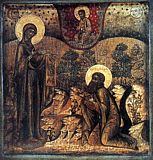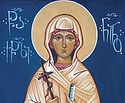

| Previous day | Next day |
| Old Style
May 19
|
Saturday |
New Style
June 1
|
| 5th Week after Pascha. Tone 4. | No fast.
|
![]() Hieromartyrs Patrick, bishop of Prusa, and his companions: priests Acacius, Menander, and Polyenus (ca. 100).
Hieromartyrs Patrick, bishop of Prusa, and his companions: priests Acacius, Menander, and Polyenus (ca. 100). ![]() St. Cornelius, founder of Komel Monastery (Vologda) (1537).
St. Cornelius, founder of Komel Monastery (Vologda) (1537). ![]() St. Demetrius Donskoy, great prince of Moscow (1389). and his wife St. Eudocia, in monasticism Euphrosyne, princess of Moscow (1407).
St. Demetrius Donskoy, great prince of Moscow (1389). and his wife St. Eudocia, in monasticism Euphrosyne, princess of Moscow (1407).
Martyr Acoluthus of Hermopolis, Egypt (284-303). St. John, bishop of Gothia in the Crimea (790). St. Cornelius, founder of Paleostrov Monastery (Karelia) (ca. 1420) and his disciple Abramius (15th c.). St. John, prince of Uglich, tonsured as Ignatius (Vologda) (1523). St. Sergius, monk, of Shukhtom (1609). Right-believing Prince Vladimir II (Basil) Monomakh of Kievan Rus (1125). St. Nicholas Rynin, fool-for-Christ, of Vologda (1837).
New Hieromartyrs Anthony (Pankeyev), bishop of Belgorod, and with him priests Mitrophan, Alexander, Michael, Matthew, Hippolytus, Nicholas, Basil, Nicholas, Maxim, Alexander, Paul, and Paul; and Martyrs Michael and Gregory (1938). New Hieromartyr Onuphrius (Gagaliuk), archbishop of Kursk and Oboyansk (1938). New Hieromartyr Valentin (Lukianov), hieromonk, of Romashkovo (Moscow) (1940). Synaxis of the Hieromartyrs of Kharkov.
Martyrs Parthenius and his brother Calogerius at Rome (250). St. Theotima of Nicomedia (311). Entrance into Georgia of St. Nina (Nino), Equal-to the-Apostles (323). St. Dunstan, archbishop of Canterbury (988). Monk-martyrs and confessors John, Conon, Jeremiah, Cyril, Theoctistus, Barnabas, Maximus, Theognostus, Joseph, Gennadius, Gerasimus, Mark, and Herman, of Kantara Monastery on Cyprus, who suffered under the Latins (1231).
Commemoration of the ascetics of St. Athanasius of Syandem Monastery: Elias (also of Valaam), Theophanes, and Dionysius. Repose of Elder Cleopas of Valaam, disciple of St. Paisius (Velichkovsky) (1816).
Thoughts for Each Day of the Year
According to the Daily Church Readings from the Word of God
By St. Theophan the Recluse

Saturday. [Acts 15:35–41; John 10:27–38]
Though ye believe not Me, believe the works, says the Lord (John 10:38). The works of the Lord were obvious to all, and He could point to them openly. They are: the healing of various diseases, the driving out of demons, power over nature, knowledge of thoughts of the heart, the prophesying of the future, power of the word, and dominion over souls. All of these clearly proved that Jesus Christ was from God, and that His word was the truth. For us other works were added to these—a marvellous death, resurrection, ascension, descent of the Holy Spirit, foundation of the Church, marvellous spiritual gifts in believers, triumph over pagans and grace-filled power which to this day has not ceased to act in the Church of God. All of these are the works of the Lord. To any unbeliever one can say: if you do not believe the word, believe these works, which loudly witness to the Godhood of our Lord Jesus Christ; and having come to belief, accept His entire truth. But how did those Jews answer the Lord at that time? They sought again to take him (John 10:39). What do today’s unbelievers do? They sit and weave lie onto lie, in order to “take” not the Lord—for this is not according to their strength—but to take those who are simple in faith and cannot unravel their sly weavings.
Articles
 Hieromartyr Patrick the Bishop of Prusa with his companionsSaint Patrick lived during the first century and was bishop of the city of Prusa in Bythnia (Asia Minor). |
 Venerable Cornelius the Abbot of Komel, VologdaSaint Cornelius of Komel was descended from the boyar (noble) family Kriukov. His brother Lukian served at the court of the Great Prince of Moscow. |
 Martyr Caluf of EgyptThe Holy Martyr Caluf the Egyptian lived during the third century, and was from the city of Thebes. |
 Right-believing John the Prince of Uglich, Tonsured As Ignatius, VologdaThe holy Prince John of Uglich was a devout and God-fearing Christian from his youth. |
 Venerable Sergius of ShukhtomSaint Sergius of Shukhtom (in the world Stephen) was born at Kazan. For three years he traveled to the holy places of Palestine and Greece, studying the monastic life. |






